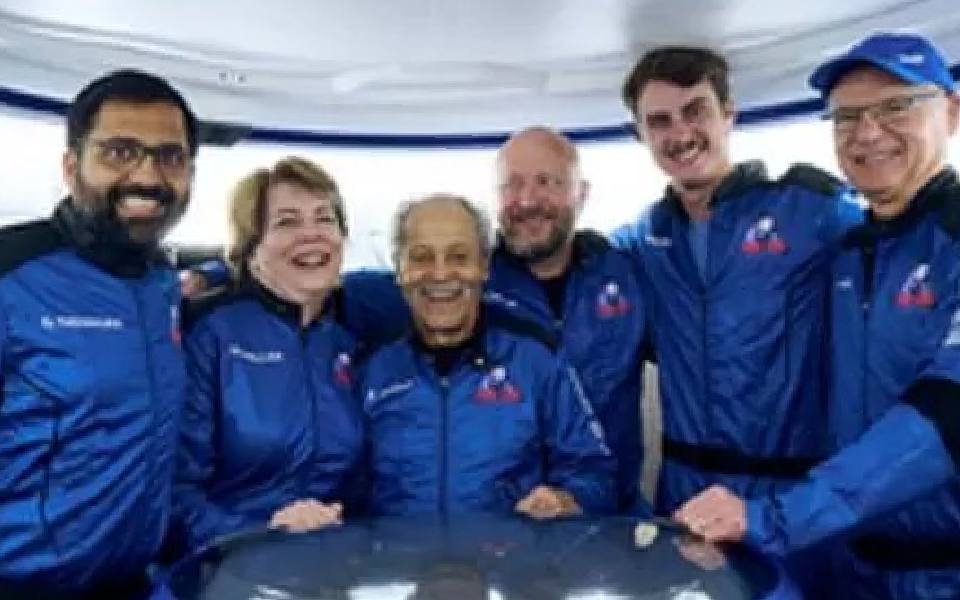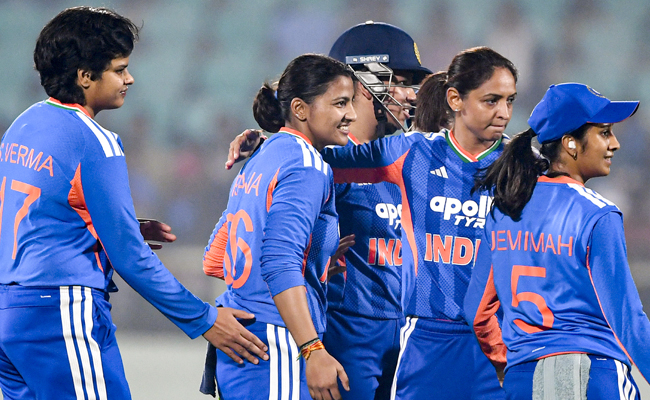Washington, May 19: Gopi Thotakura, an entrepreneur and a pilot, on Sunday became the first Indian to venture into space as a tourist aboard Amazon founder Jeff Bezos's Blue Origin’s NS-25 mission.
Thotakura was selected as one of the six crew members for the NS-25 mission, making him the first Indian space tourist and the second Indian to venture into space after the Indian Army's Wing Commander Rakesh Sharma in 1984.
Blue Origin's seventh human flight, NS-25, lifted off from Launch Site One in West Texas on Sunday morning, the company announced on social media.
This mission was the seventh human flight for the New Shepard programme and the 25th in its history. To date, the programme has flown 31 humans above the Karman line, the proposed conventional boundary between Earth's atmosphere and outer space.
New Shepard is a fully reusable sub-orbital launch vehicle developed for space tourism by Blue Origin.
According to Blue Origin, "Gopi is a pilot and aviator who learned how to fly before he could drive."
He co-founded Preserve Life Corp, a global centre for holistic wellness and applied health located near Hartsfield-Jackson Atlanta International Airport.
In addition to flying jets commercially, he pilots bush, aerobatic, and seaplanes, as well as gliders and hot air balloons, and has served as an international medical jet pilot.
A lifelong traveller, his most recent adventure took him to the summit of Mt Kilimanjaro in Tanzania.
Andhra Pradesh-born Thotakura is a graduate of Embry-Riddle Aeronautical University.
Other crew members of the flight include Mason Angel, Sylvain Chiron, Kenneth L. Hess, Carol Schaller, and former Air Force Captain Ed Dwight, who was selected by President John F Kennedy in 1961 as the nation's first Black astronaut candidate but was never granted the opportunity to fly to space.
The rocket booster landed safely a couple minutes prior to the capsule, CNN reported.
During the mission, the crew soared to more than three times the speed of sound. The rocket vaulted the capsule past the Kármán line, an area 100 kilometers above Earth’s surface that is widely recognized as the altitude at which outer space begins — but there’s a lot of gray area, the channel said.
At the peak of the flight, passengers experienced a few minutes of weightlessness and striking views of Earth through the cabin windows, it added.
During the flight, each astronaut carried a postcard to space on behalf of Blue Origin’s foundation, Club for the Future.
This programme gives students access to space on Blue Origin’s rockets, including an all-digital method to create and send postcards. The Club’s mission is to inspire and mobilise future generations to pursue careers in STEAM (science, technology, engineering, arts and mathematics) for the benefit of Earth.
From an environmental standpoint, nearly 99 per cent of New Shepard’s dry mass is reused, including the booster, capsule, engine, landing gear, and parachutes.
New Shepard’s engine is fuelled by highly efficient liquid oxygen and hydrogen. During the flight, the only byproduct is water vapour with no carbon emissions, the company earlier said.
Blue Origin released the NS-25 mission patch. A few of the symbols embedded include: The Gemini spacecraft represents Dwight’s aerospace training era. The hand lifting of the crew capsule is a nod to his extensive artwork.
The sunrise represents Angel and Schaller’s desire to experience the overview effect. The mountains symbolise Schaller, Thotakura, and Chiron’s passion for climbing and skiing.
Jeff Bezos’ space company had paused its suborbital tourism programme following a liftoff malfunction of the New Shepard rocket. In September 2022, an uncrewed flight of New Shepard ended in flames around a minute after liftoff.
Let the Truth be known. If you read VB and like VB, please be a VB Supporter and Help us deliver the Truth to one and all.
Visakhapatnam (PTI): Shafali Verma hit a blistering unbeaten 69 as India made short work of a paltry target to outclass Sri Lanka by seven wickets in the second Women’s T20 International here on Tuesday.
India now lead the five-match series 2-0 after another one-sided victory, having restricted Sri Lanka to a modest 128 for 9 through a collective display of disciplined bowling from the spin trio of seasoned Sneh Rana, ably complemented by young spinners Vaishnavi Sharma and Shree Charani.
During the chase, vice-captain Smriti Mandhana (14) fell cheaply but Shafali, enjoying new found confidence after a stellar show in the World Cup final, sent the bowlers on a leather-hunt during her 34-ball knock, winning it for her team in just 11.5 overs.
The hosts have now completed back-to-back successful chases within 15 overs which speaks volumes about the unit's sky-high confidence.
Shafali's innings had 11 punchy boundaries apart from a maximum.
The floodgates opened when left-arm spinner Inoka Ranaweera bowled a few flighted deliveries and Shafali would step out everytime to hit her over extra cover. Her footwork against slow bowlers was immaculate whether stepping out to loft the ball or rocking back to punch or pull.
Seeing her confidence, the newly appointed Delhi Capitals skipper Jemimah Rodrigues (26 off 15 balls) also attacked as the duo added 58 runs in just 4.3 overs.
By the time Rodrigues was out trying to hit one six too many, the match as a contest was over. Shafali completed her half-century off just 27 balls and completed the formalities in a jiffy.
Earlier, off-spinner Rana, who got a look-in after Deepti Sharma was ruled out due to fever, showed her utility keeping the Lankan batters under tight leash with figures of 1 for 11 in 4 overs, including a maiden which certainly is a rarity in T20 cricket.
Charani, who made an impression during India's ODI World Cup triumph, took 2 for 23 in her quota of overs, while Vaishnavi after an impressive debut in the opening encounter, finished with 2 for 32, not letting the Islanders get easy runs in her second spell.
The last six wickets fell for just 24 runs, but what stood out during India’s bowling effort was their superb ground fielding. After a patchy show in the previous game, the improved sharpness in the field resulted in three run-outs.
Sri Lankan skipper Chamari Athapaththu (31 off 24 balls) looked in good nick as she deposited length deliveries from seamers Kranti Gaud and Arundhati Reddy over the ropes but it was Rana, who kept her quiet by repeatedly pitching on good length.
Unable to manoeuvre the strike and with the big hits suddenly drying up, Athapaththu chanced her arm at another delivery in which Rana had shortened the length slightly.
Not having transferred the weight into the lofted shot, Athapaththu's hoick was pouched cleanly by Amanjot Kaur at long-off.
This was after Athapaththu's opening partner Vishmi Gunaratne (1) had offered a simple return catch to Gaud.
Hasini Perera (22 off 28 balls) and Harshitha Samarawickrama (33 off 32 balls) did stitch a stand of 44 but they could never set the tempo against the Indian spin troika.
Once Hasini offered a tame return catch off a Charani full-toss, Sri Lankans never recovered and lost wickets in a heap towards the end.





